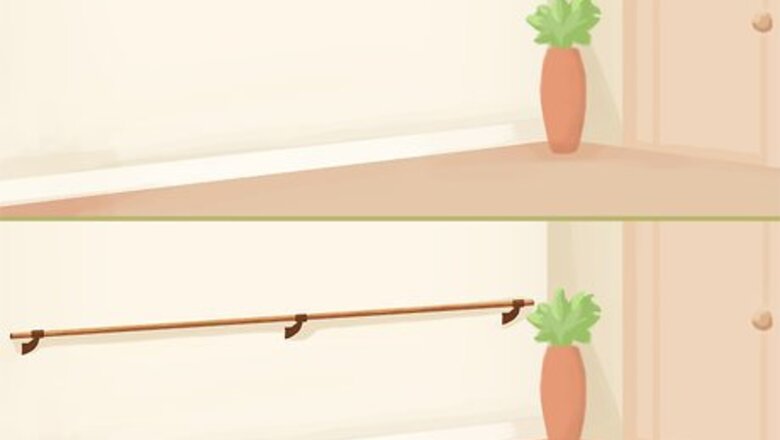
views
Warming Up and Stretching
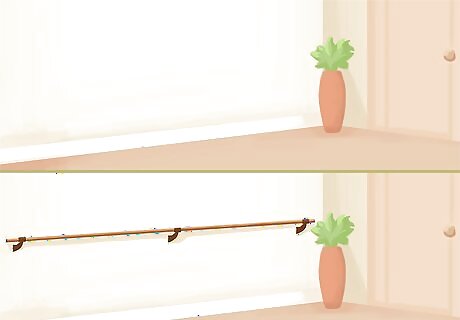
Choose a room that has space for you to move around. Make sure you have room to bend, leap, and move across the floor without bumping into anything. Remove any items that might impede your movement, like a coffee table or items on the floor. If your room doesn't have a ballet barre, use the back of a sturdy chair for support when you need it.Tip: If you're passionate about ballet, install a ballet barre on the wall of your room. This will make it much easier to practice.
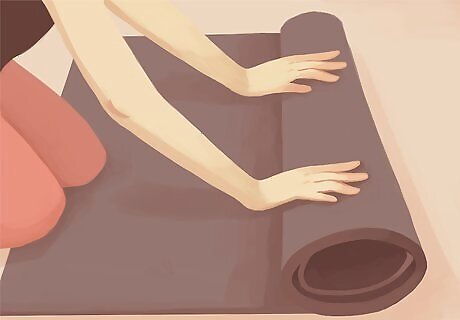
Cover the floor with a mat or rug if it's a hard surface. Don't do ballet on hard surfaces like concrete unless you put down a mat. Jumping on a hard floor can damage your joints, including your knees. Use an exercise mat or rug to cover hard flooring. Alternatively, do ballet in a room that's carpeted. You can find rubber mats that are made for ballet online.
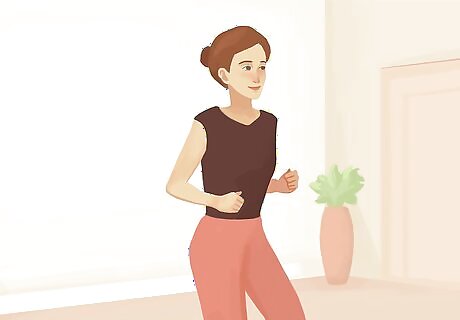
Warm up your body by doing 5 minutes of low-impact cardio. Your muscles need to be warm before you do ballet to help you avoid injury. To quickly warm-up, walk or jog in place for about 5 minutes. If you like, finish your warm-up with a series of squats, lunges, and jumping jacks. Make sure you warm up before you stretch because stretching cold muscles increases your risk of injury.
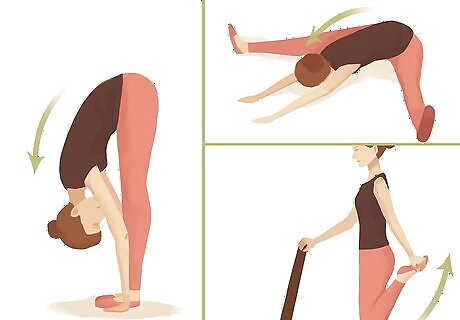
Stretch your muscles after you're warmed up. Once your body's warmed up, stretch your muscles so they're ready for your ballet moves. Here are some stretches to try: Do a forward bend: Stand up straight with your feet together and your toes pointing forward. Hinge forward at your waist and reach down to the floor. Go down as far as you can and try to touch the floor. Hold for 30 seconds. Do a wide-leg stretch: Sit on the floor and spread your legs out in a “V.” Point your toes up into the air. Lean forward and reach between your legs as far as you can. Hold for 30 seconds. Stretch your quads: Your quads are the front of your thighs. Stand up straight with your legs together and hold onto a chair for support. Lift 1 leg behind you and grasp the top of your foot with your hand. Pull your foot into your butt. Hold for 30 seconds, then switch legs.
Practicing the 5 Positions in Ballet
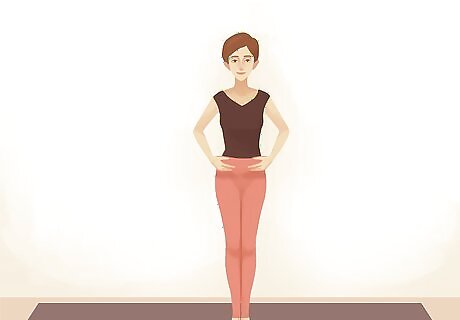
Start with the first position because it's the easiest. Stand up straight with your legs together and your heels touching. Turn your toes so they point outwards in a “V.” Then, lift your arms in front of you to make an oval. Your fingers shouldn't be touching. Point your toes out as far as you can. At first, you might only be able to make a narrow "V." However, you'll become more flexible over time and may eventually be able to turn your toes out.
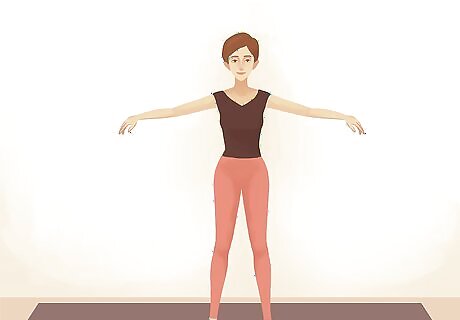
Do the second position to add more ballet moves. Stand tall with your legs spread slightly wider than shoulder-width apart. Point your toes outward away from your body. Spread your arms out at your sides, keeping them grounded and at about shoulder height. Like with the first position, only turn your toes out as far as you comfortably can.
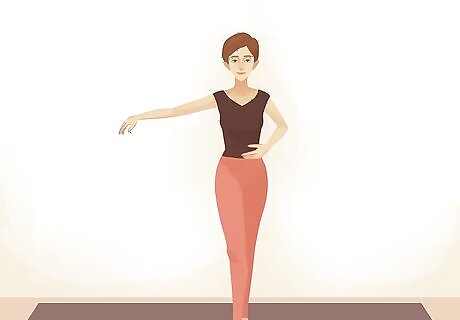
Try the third position to help you gain experience. Stand up straight and cross your right leg over your left with the heel of your right foot in front of your left arch. Then, curve your right arm toward your body while keeping your left arm out to the side. Alternatively, cross your left leg over your right and curve your left arm. You can do the third position with either your right arm and leg or your left arm and leg. You might put your arms into the third position as you perform leaps and jumps.

Add the fourth position when you're flexible enough to do it comfortably. For an open 4th position, place 1 foot 12 in (30 cm) in front of the other with your heels aligned and your toes pointed out. Lift the corresponding arm over your head with your arm curved. For a closed 4th position, cross 1 leg over the other and align your front heel with your back toes. Then, lift your arm over your head, keeping your arm curved. Sometimes you may put your arms into the fourth position during leaps and jumps.
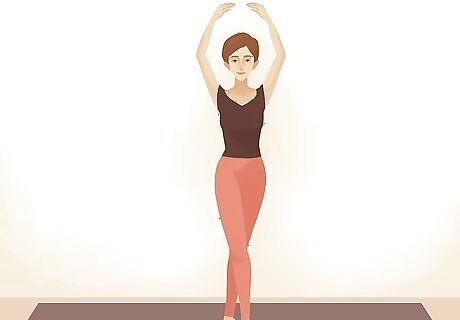
Perform 5th position when you're ready to advance your technique. Place 1 foot in front of the other with your toes pointed out. Close your feet together with your front toe in line with your back heel and your back heel in line with your front heel. Then, lift your arms gracefully over your head, keeping them curved. This position is difficult so don't attempt it until you're flexible enough to do it. Like with the other positions, you may do leaps and jumps with your arms in the 5th position. It's okay to put your arms in the 5th position when you're just a beginner. It's the footwork that's challenging.
Doing Beginner Ballet Moves
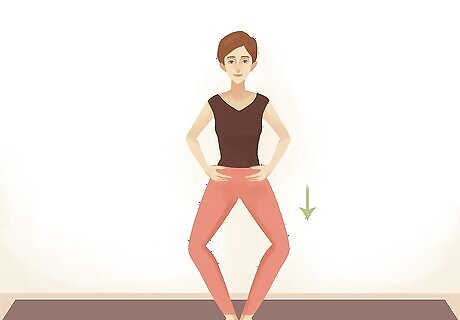
Do demi pliés in first position. Get into the first position by standing with your legs together and your toes pointed out. Lift your arms out in front of you and form them into an oval. Bend your knees and slowly lower your body down toward the ground, keeping your heels flat on the floor. Squeeze your muscles in as you come back up. This is called a demi plié. In French demi means half. So, with a demi-pliè, you will only go a quarter to a half of the way down depending on the style of ballet. Pliés are pronounced as Plea-AE. You can hold onto a ballet barre or the back of a chair for support if you need it. Always start with lightly placing a hand on something to help stabilize you. At home, your makeshift barre should be slightly above elbow height. Remember the barre is only there to help if and when needed. Try not to become dependent on the barre for balance. Work on finding your balance by going through the moves slowly pause in each one until you feel you have a stable connection to the ground then slowly move to your next position or move. Doing this will help when you advance. and move to center work. After you can do a demi plié, move on to the grande pliés. It's the same move, except that you lift your heels off the floor. This is similar to a squat but you have your heels together and your toes pointed out. Variation: Once you master the plié in the first position, try it in the second position. Each time you perfect your form, try the plié in the next position.
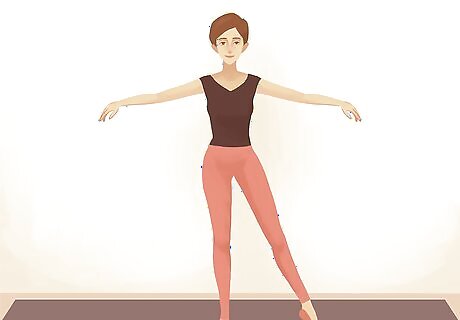
Do tendues in the first position. Stand up tall with your heels together and your toes pointed out. Push your foot against the floor as you slide it out to the front, side, or back. Lift your heel to point your toe. Then, slowly lower your foot from the point down to the floor and drag your foot across the floor back to the first position. Tendues are pronounced Ton-DUE. (Like fondue but with a T) After you master the first position, try tendues in the other positions. (work on tendue from all 5 positions this is a good warmup for your legs at the barre) You can use a tendue to transition from the first to the second position. Do a tendue to the side, then lower your foot to the floor instead of bringing it back in.

Perform releves in the first position. Stand tall with your heels together and your toes pointed out. Slowly lift your heels off the ground as high as you can. Pause for 2-3 seconds, then slowly lower your heels back to the floor. Releve is pronounced, “rel uh VEY.” After you master releves in the first position, try them in the other positions, as well.
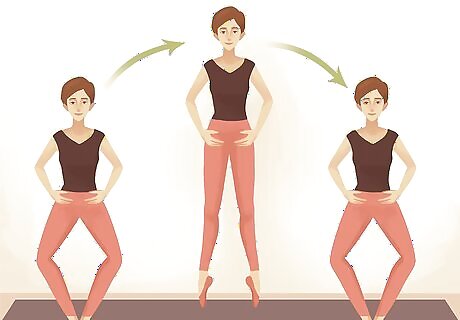
Perform sautés when you're ready for a basic jump. Do a demi plié in the first position with your core engaged and your upper body lifted. Then, spring off the ground and land in a demi plié. As you jump, lift your feet heel to toe, then land by putting your feet down toe to heel. Typically, you'll do sets of 4, 6, or 8 sautés. Pay attention to your form so that each sauté is performed correctly. Once you master this, practice doing it in the second position.
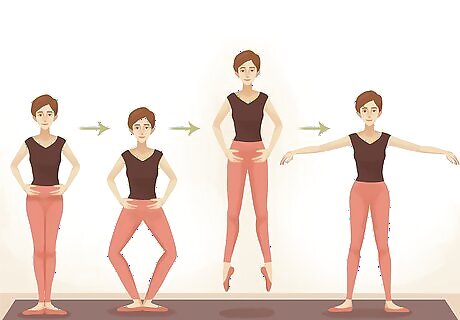
Do an échappé to shift from first to the second position. Start in the first position with your heels together, your toes pointed out, and your arms curved into an oval out in front of you. Do a demi plié, then leap off of the floor in a sauté. Open your legs and land in the second position with your legs spread slightly wider than shoulder-width apart and your arms spread out at your sides. An échappé is pronounced A-sha-PAY. Do several jumps shifting from first to second, then second to first. You can also do an échappé to shift from fifth to the second position.
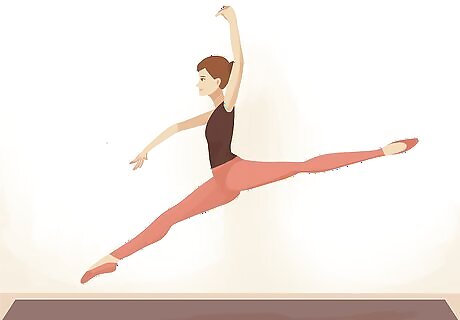
Perform grand jetés to add leaps. Grand jetés are leaps where you extend 1 leg in front of your body and 1 leg behind your body. Place your arms in the fourth or fifth position. Take a small hop forward with 1 leg, then leap into the air to do your grand jeté. Split your legs and extend them out straight with your toes pointed. Jeté is pronounced Zha-TAE. Jump as high as you can without overexerting your body or bending your knees. With practice, you'll be able to jump higher and spread your legs further.
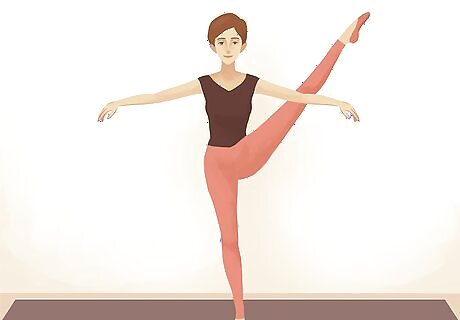
Try grand battements to incorporate kicks. A grand battement is a kick with a pointed toe and straight leg, which you can do to the front, side, or back. Put your arms in the second position. Brush your foot across the floor, then lift it into a kick. Lift your kick as high as you can, pointing your toe. Keep your standing leg straight as you kick. Grand battement is pronounced GROND Bot-MAH. When you're doing a grand battement to the back, lean forward slightly but don't bend at your waist. Try to lift your leg at least 90 degrees off the ground, but don't push yourself further than your range of motion can go. As you practice, you'll be able to lift your leg further off the ground. You can do grand battements with your arms in other positions as you get better at the ballet.
Advancing Your Technique
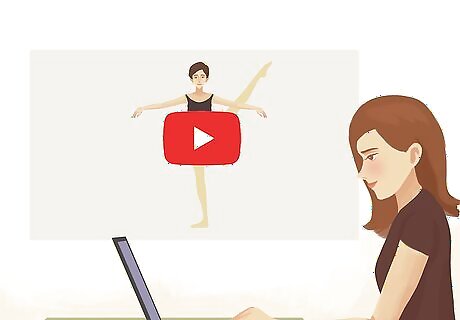
Watch ballet tutorials online using sites like YouTube. If you can't afford lessons, video tutorials are a great alternative. While they're not as helpful as learning from a teacher, tutorials can teach you basic ballet if you practice several days a week. Look for tutorials for moves you want to try, then follow along carefully. Subscribe to ballet channels that you find helpful. Keep in mind that you'll likely need lessons if you're wanting to become an advanced dancer. However, video tutorials are a great way to start and can help you enjoy ballet as a hobby.
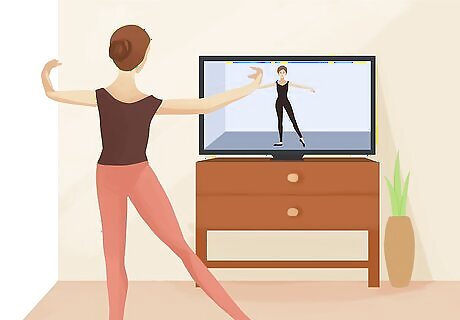
Follow along with a video lesson. Video lessons are available on DVD or streaming sites. These lessons are taught by professional teachers, so they can teach you advanced moves. It won't be the same as working one-on-one with an instructor, but these lessons will help you develop your dancing technique. Look for video workouts online. Watch a preview of the workout before you buy it to see if you can follow the instruction. Pick a video that's at your level. If you're a beginner, look for a step-by-step video to help you learn.
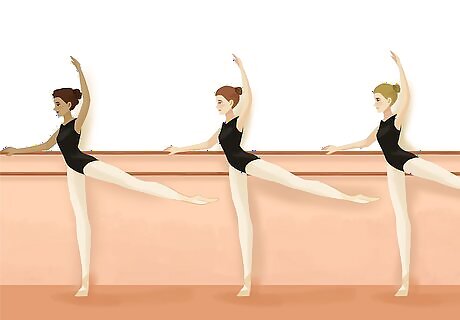
Take classes in person for personalized instruction. Attending classes with an instructor allows you to get feedback on your form so you can make improvements. Additionally, you'll learn ballet faster and safely proceed to more advanced moves. Attending classes will also allow you to learn choreography and perform in front of an audience. Look for classes in your area by searching online. If you've been practicing at home and can't afford classes, ask the school if they have a scholarship or internship program. You may be able to earn a scholarship if you show talent and dedication, or you might be able to get a class discount if you help out around the studio.




















Comments
0 comment